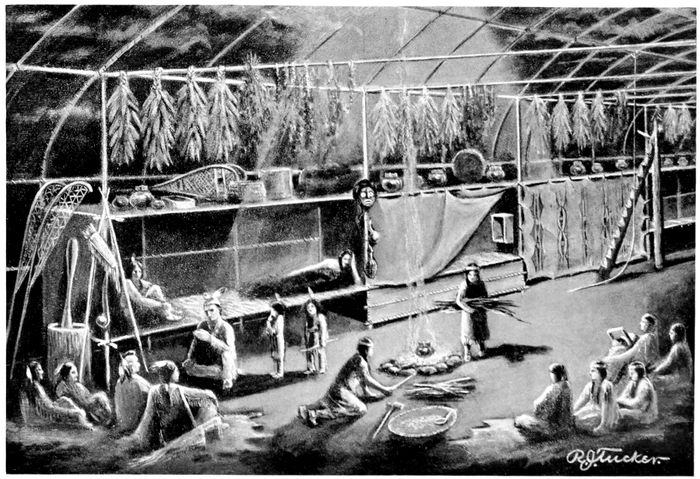Transcriber’s Note:
The cover image was created by the transcriber and is placed in the public domain.

THE ATMOSPHERE IN WHICH LEGENDS WERE TOLD.
From a Painting Showing the Interior of a Bark Long house, by Richard J. Tucker.
SENECA MYTHS AND FOLK TALES
WHOSE NUMEROUS ESSAYS AND HISTORICALWRITINGS HAVE BEEN A SOURCE OFINSPIRATION AND ENLIGHTENMENT, ANDWHOSE INTEREST IN THE SENECA INDIANSAND THEIR HISTORY HAS NEVER WANED,THIS VOLUME OF
IS DEDICATED IN TESTIMONY OF THEAUTHOR’S SINCERE ADMIRATION ANDESTEEM.
FOREWORD
The author of this collection of Seneca folk-tales cannotremember when he first began to hear the wonderstories of the ancient days. His earliest recollections areof hearing the wise old men relate these tales of the mysteriouspast. They were called Kă´kāā, or Gă´kāā, and whenthis word was uttered, as a signal that the marvels of oldwere about to be unfolded, all the children grew silent,—andlistened. In those days, back on the Cattaraugus reservation,it was a part of a child’s initial training to learn whythe bear lost its tail, why the chipmunk has a striped backand why meteors flash in the sky.
Many years later,—it was in 1903,—the writer of thismanuscript returned to the Cattaraugus reservation bringingwith him his friend Mr. Raymond Harrington, for thepurpose of making an archæological survey of the Cattaraugusvalley for the Peabody Museum of Archæology, ofHarvard University. Our base camp was on the old Silverheelsfarm, which occupies the site of one of the earlySeneca villages of the period af